- Home
- Garden Wildlife
- Insects
- Dragons/damsels
- Damselflies
Damselflies
Damselflies are insects in the order Odonata, sub-order Zygoptera, and are generally smaller and more lightly built than their larger relatives the dragonflies, but share a very similar predatory way of life. See our introduction page for more on the biology of these attractive insects.
Species in Britain and Ireland
There are about 20 species of damselflies recorded in Britain and Ireland, but some require moving water to breed and are not typical of small garden ponds. Jennifer Owen recorded only one species in her Leicester garden, but four species are commonly seen in gardens.
Blue-tailed damselfly Ischnura elegans
This is the commonest damselfly species in gardens, and the male at least is easily identified by its distinctive bright blue tip to the abdomen. Many females alo have this (but more muted in colour), but in others this patch can be brownish (form infusca) missing (form obsoleta), while some immature females have a reddish thorax colour (form rufescens). These forms can co-exist in an individual, making the females very variable in colour. Blue-tailed damselfly adults fly from April to October.
Other sources of information
Websites
Website of the British Dragonfly Society
Steve Falk's pages and information on odonata.
Facebook group UK Dragonflies and damselflies
Facebook Group British Butterflies Moths and Dragonflies
Natural England leaflet on dragonflies and damselflies
Books
Smallshire, D and Swash, A (2018) Britain's Dragonflies: A Field Guide to the Damselflies and Dragonflies of Great Britain and Ireland. Wild Guides
Brooks, S., Cham, S. and Lewington, R. (2018) Field Guide to the dragonflies and damselflies of Great Britain and Ireland. Bloomsbury Wildlife Guides
Cham, S. (2012) Field Guide to the larvae and exuviae of British Dragonflies - Dragonflies (Anisoptera) and Damselflies (Zygoptera). British Dragonfly Society
Corbet, P. & Brooks, S. (2008) Dragonflies Collins New Naturalist series no 106. Harper Collins
Page text drafted by Andrew Halstead, reviewed by Andrew Salisbury, compiled by Steve Head
Common blue damselfly Enallagma cyathigerum
This is superficially similar to the azure damselfly, but has much wider blue or green colour stripes on the top of the thorax. The insect is very common (and the one recorded by Jennifer Owen). It flies in April to October.
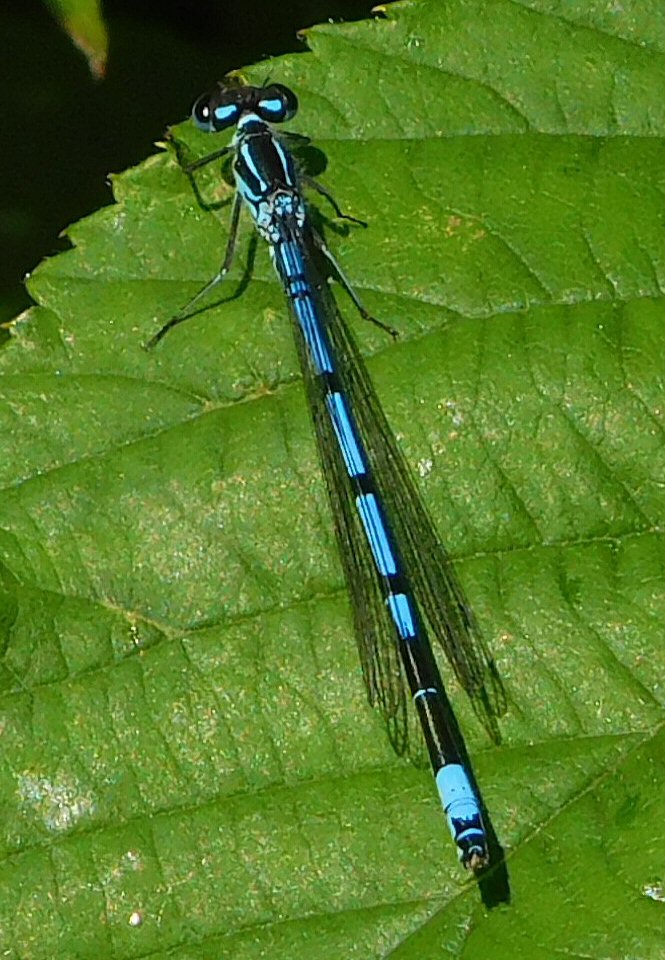
_female_.jpg)
Common blue damselfly Enallagma cyathigerum Left: male, Right: female
Large red damselfly Pyrrhosoma nymphula
This is our largest garden species, and quite common. Both sexes are spectacular in colour, the male in particular being a vivid scarlet-red abdomen, with splendid red shoulder-stripes on the thorax. Most females are slightly browner-red in colour, and some have yellow shoulder stripes instead of red. They appear early in the year, flying from March to September
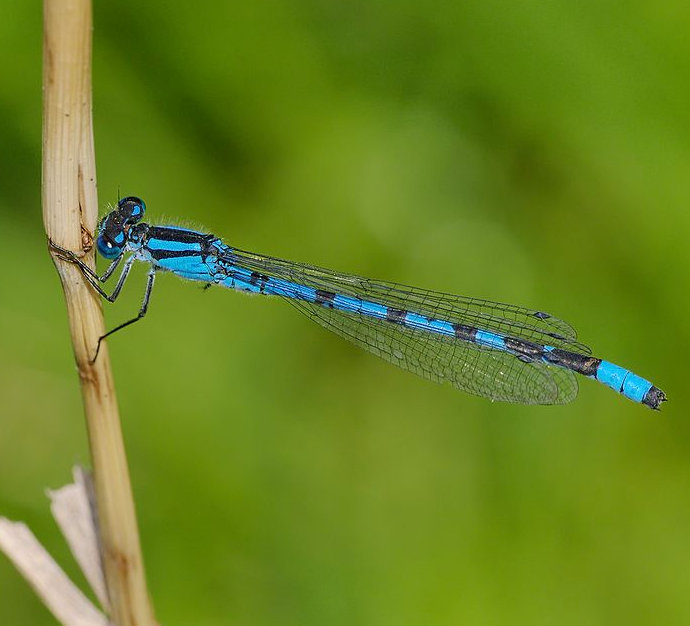
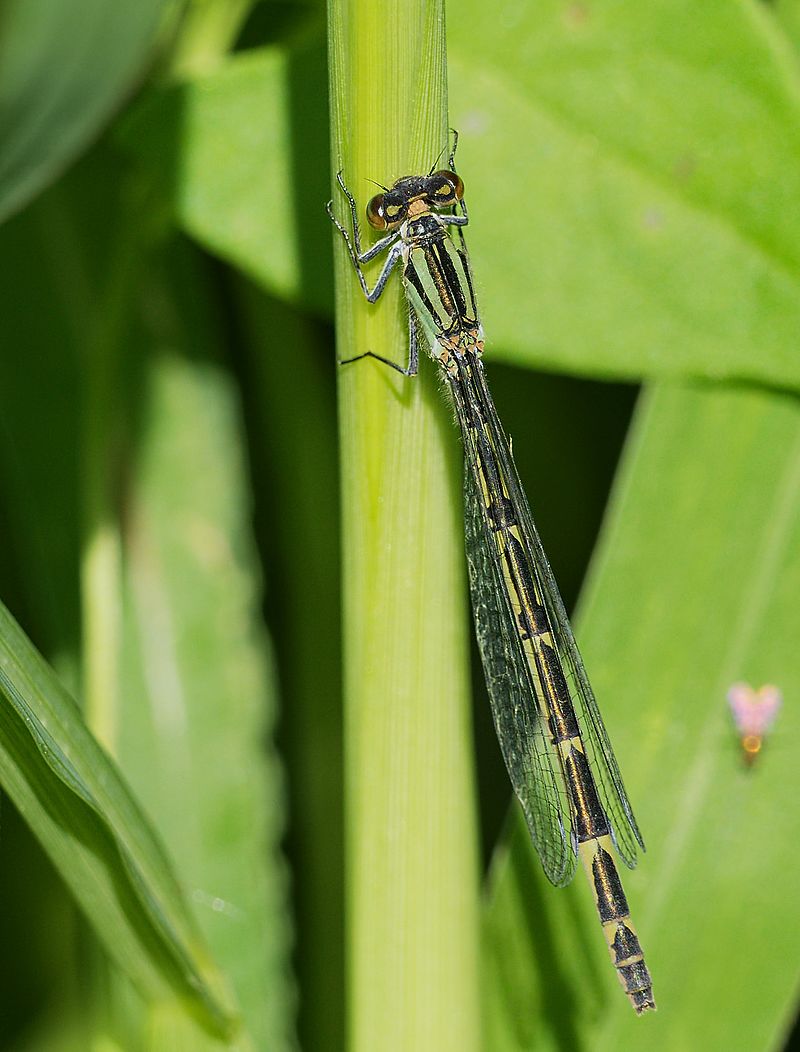
Azure damselfly Coenagrion puella
This is one of the most common garden species. The male is blue and black, while the female is generally black and green. They fly from April to September. Like most damselflies, the larva feeds on water fleas, other small crustaceans and the larvae of other insects. Note the cerci and central filament at the rear.
_nymph.jpg)
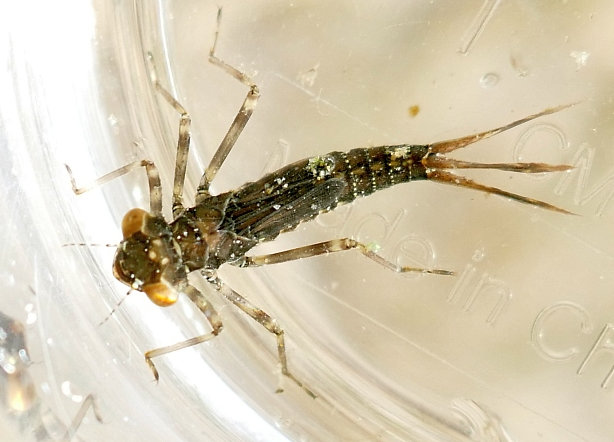
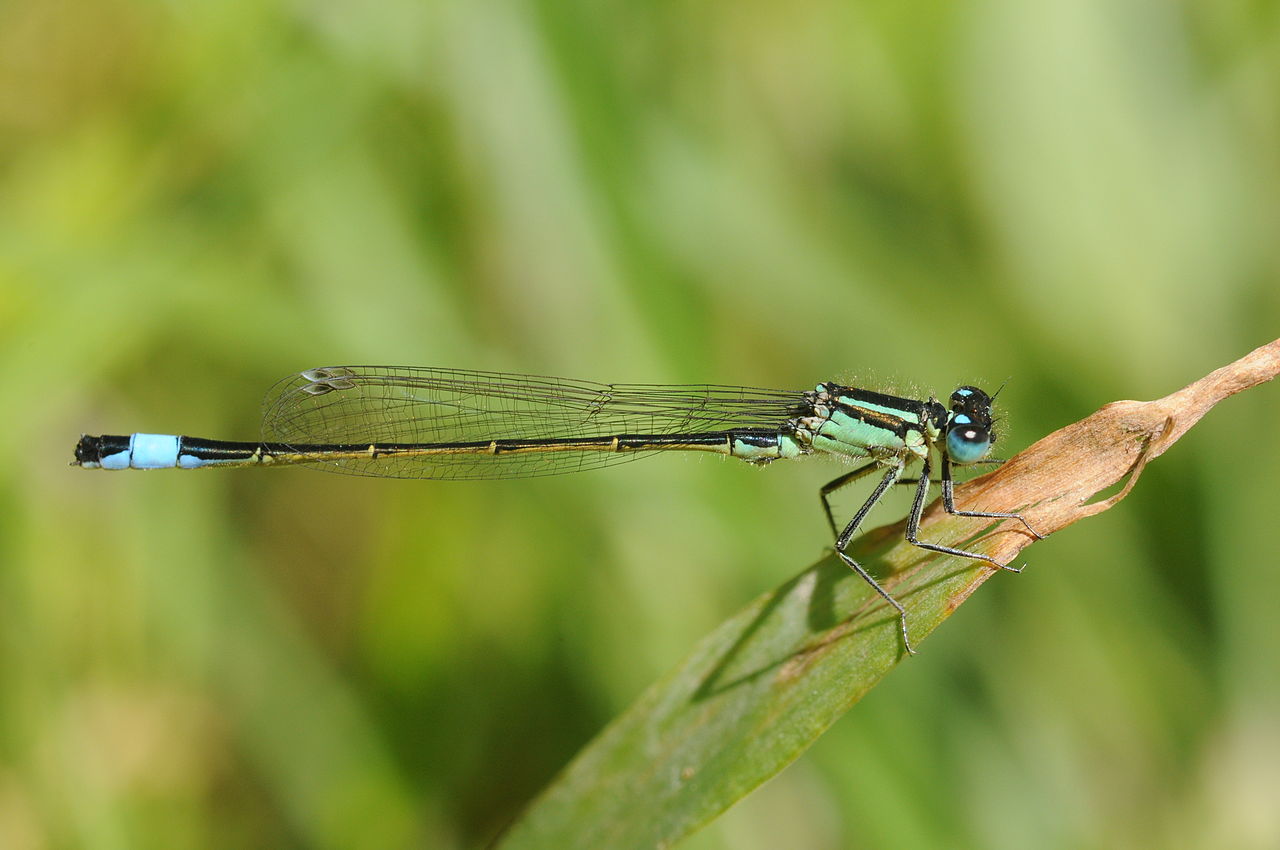
_female.jpg)
_female_infuscans_obsoleta.jpg)
Blue-tailed damselfly Ischnura elegans. Top left: Male with distinctive blue patch on the abdoment tip. Top right: typical female form with slightly duller blue patch.
Below left: female form infuscans obsoleta, with the abdomen patch brown and practically absent. Below right: larva with the three paddle-like gills at the end of the abdomen that characterise damselfly larvae.
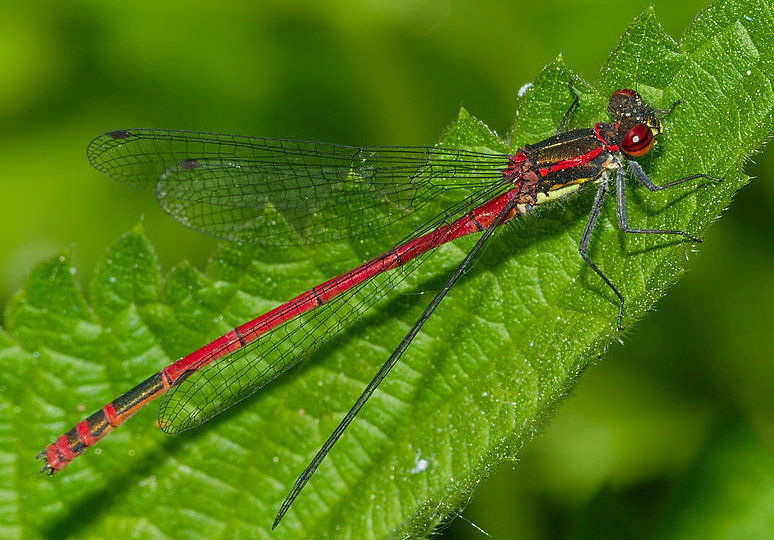
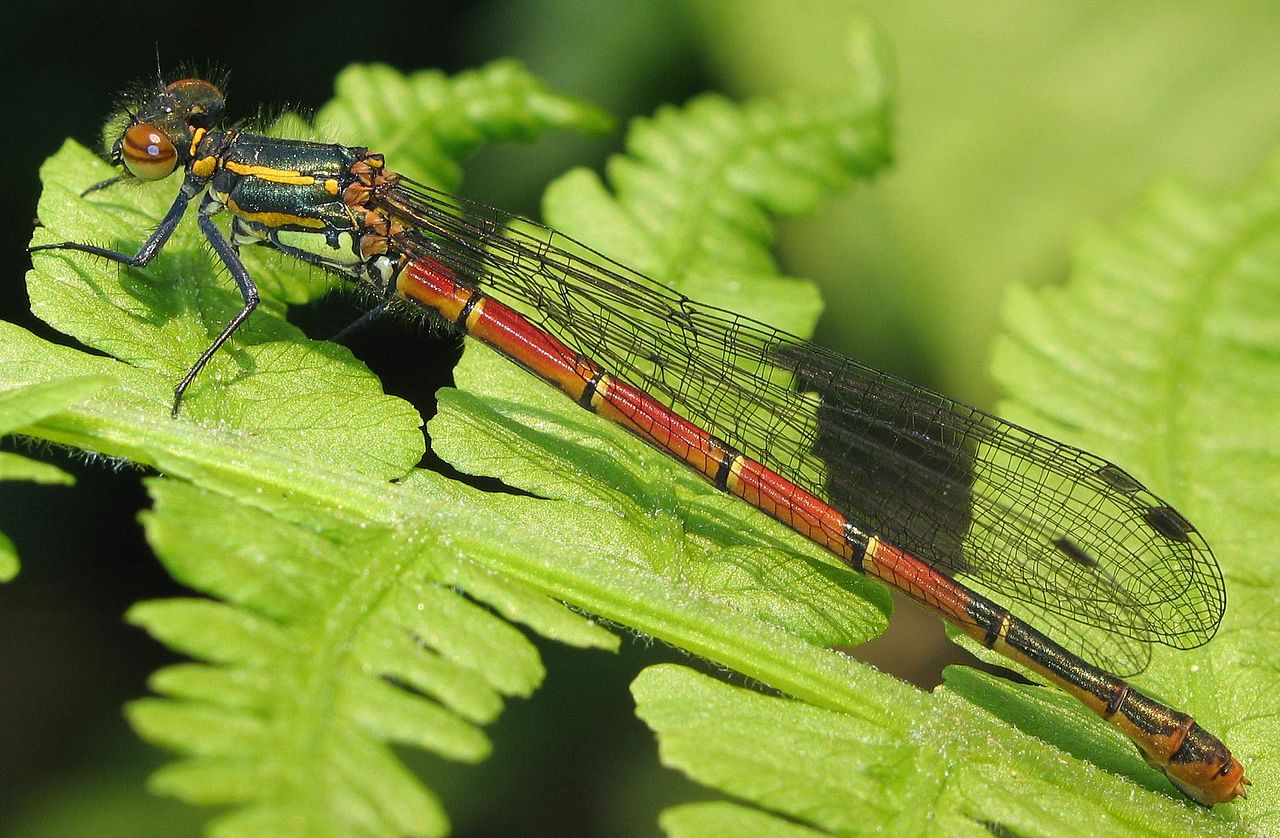
Large red damselfly Pyrrhosoma nymphula
Top left: Male. Top right: female with less vivid colour and yellow stripes on the thorax
Left: Larva.
Damselflies
Damselflies are insects in the order Odonata, sub-order Zygoptera, and are generally smaller and more lightly built than their larger relatives the dragonflies, but share a very similar predatory way of life. See our introduction page for more on the biology of these attractive insects.
Species in Britain and Ireland
There are about 20 species of damselflies recorded in Britain and Ireland, but some require moving water to breed and are not typical of small garden ponds. Jennifer Owen recorded only one species in her Leicester garden, but four species are commonly seen in gardens.
Blue-tailed damselfly Ischnura elegans
This is the commonest damselfly species in gardens, and the male at least is easily identified by its distinctive bright blue tip to the abdomen. Many females alo have this (but more muted in colour), but in others this patch can be brownish (form infusca) missing (form obsoleta), while some immature females have a reddish thorax colour (form rufescens). These forms can co-exist in an individual, making the females very variable in colour. Blue-tailed damselfly adults fly from April to October.
Damselflies
Damselflies are insects in the order Odonata, sub-order Zygoptera, and are generally smaller and more lightly built than their larger relatives the dragonflies, but share a very similar predatory way of life. See our introduction page for more on the biology of these attractive insects.
Species in Britain and Ireland
There are about 20 species of damselflies recorded in Britain and Ireland, but some require moving water to breed and are not typical of small garden ponds. Jennifer Owen recorded only one species in her Leicester garden, but four species are commonly seen in gardens.
Blue-tailed damselfly Ischnura elegans
This is the commonest damselfly species in gardens, and the male at least is easily identified by its distinctive bright blue tip to the abdomen. Many females alo have this (but more muted in colour), but in others this patch can be brownish (form infusca) missing (form obsoleta), while some immature females have a reddish thorax colour (form rufescens). These forms can co-exist in an individual, making the females very variable in colour. Blue-tailed damselfly adults fly from April to October.
Damselflies
Damselflies are insects in the order Odonata, sub-order Zygoptera, and are generally smaller and more lightly built than their larger relatives the dragonflies, but share a very similar predatory way of life. See our introduction page for more on the biology of these attractive insects.
Species in Britain and Ireland
There are about 20 species of damselflies recorded in Britain and Ireland, but some require moving water to breed and are not typical of small garden ponds. Jennifer Owen recorded only one species in her Leicester garden, but four species are commonly seen in gardens.
Blue-tailed damselfly Ischnura elegans
This is the commonest damselfly species in gardens, and the male at least is easily identified by its distinctive bright blue tip to the abdomen. Many females alo have this (but more muted in colour), but in others this patch can be brownish (form infusca) missing (form obsoleta), while some immature females have a reddish thorax colour (form rufescens). These forms can co-exist in an individual, making the females very variable in colour. Blue-tailed damselfly adults fly from April to October.

_female.jpg)
Blue-tailed damselfly Ischnura elegans. Top left: Male with distinctive blue patch on the abdoment tip. Top right: typical female form with slightly duller blue patch.
Below left: female form infuscans obsoleta, with the abdomen patch brown and practically absent. Below right: larva with the three paddle-like gills at the end of the abdomen that characterise damselfly larvae.
_female_infuscans_obsoleta.jpg)
_nymph.jpg)
Azure damselfly Coenagrion puella
This is one of the most common garden species. The male is blue and black, while the female is generally black and green. They fly from April to September. Like most damselflies, the larva feeds on water fleas, other small crustaceans and the larvae of other insects. Note the cerci and central filament at the rear.

_female_.jpg)
Common blue damselfly Enallagma cyathigerum
This is superficially similar to the azure damselfly, but has much wider blue or green colour stripes on the top of the thorax. The insect is very common (and the one recorded by Jennifer Owen). It flies in April to October.


Common blue damselfly Enallagma cyathigerum Left: male, Right: female
Large red damselfly Pyrrhosoma nymphula
This is our largest garden species, and quite common. Both sexes are spectacular in colour, the male in particular being a vivid scarlet-red abdomen, with splendid red shoulder-stripes on the thorax. Most females are slightly browner-red in colour, and some have yellow shoulder stripes instead of red. They appear early in the year, flying from March to September



Large red damselfly Pyrrhosoma nymphula
Top left: Male. Top right: female with less vivid colour and yellow stripes on the thorax
Left: Larva.
Other sources of information
Websites
Website of the British Dragonfly Society
Facebook group UK Dragonflies and damselflies
Facebook Group British Butterflies Moths and Dragonflies
Books
Smallshire, D and Swash, A (2018) Britain's Dragonflies: A Field Guide to the Damselflies and Dragonflies of Great Britain and Ireland. Wild Guides
Brooks, S., Cham, S. and Lewington, R. (2018) Field Guide to the dragonflies and damselflies of Great Britain and Ireland. Bloomsbury Wildlife Guides
Cham, S. (2012) Field Guide to the larvae and exuviae of British Dragonflies - Dragonflies (Anisoptera) and Damselflies (Zygoptera). British Dragonfly Society
Corbet, P. & Brooks, S. (2008) Dragonflies Collins New Naturalist series no 106. Harper Collins
Page text drafted by Andrew Halstead, reviewed by Andrew Salisbury, compiled by Steve Head












